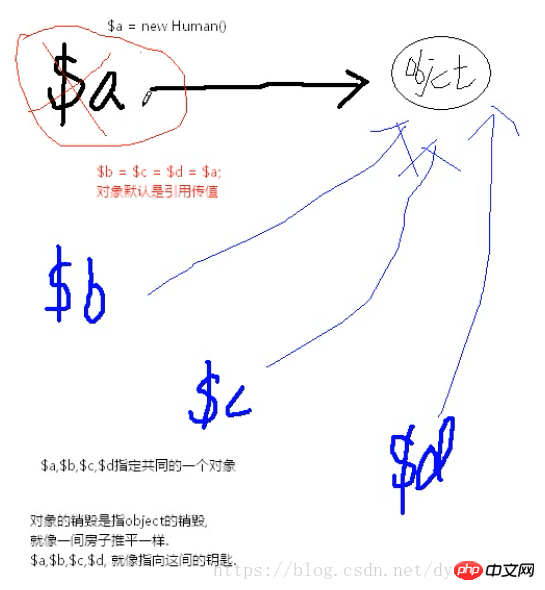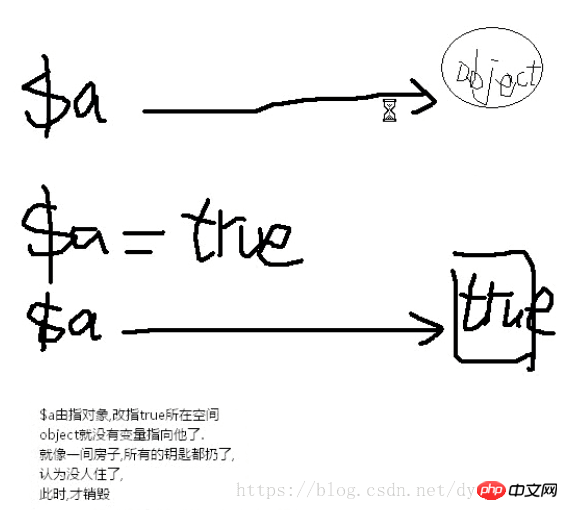PHP destructor and recycling mechanism
This article introduces the content of PHP destructor and recycling mechanism, which has certain reference value. Now I share it with everyone. Friends in need can refer to it
// ===Notes section 1===
/*
Question
1. Will assigning the object to something else, such as true, destroy the object?
Answer: Yes
2. Code part 4 in 110.php
Why is one destroyed and 2 empty
The last one will appear under the hr line?
Answer: The last one is destroyed because the php page has been executed.
Finally the system recycles and $d is destroyed at this time.
So it is displayed behind the hr line
*/
// ===Code part 1===
class Human2 {
public $name = null; public $gender = null; public function __construct() {
echo '出生了<br >';
} public function __destruct() {
echo '再见<br >';
}
}$a = new Human2();$b = new Human2();$c = new Human2();$d = new Human2();unset($a);//$b = false;$b = true;//改成true也可以销毁$c = null;echo '<hr >';
// Object recycling mechanism
// == =Code part 2===
class Human {
public $name = null; public $gender = null; public function __destruct() {
echo '再见!<br >';
}
}$a = new Human();$b = $c = $d = $a;unset($a);echo '<hr >';/*
Then the question is:
1. How many times have you died?
2. Will you die on the HR line or off the HR line?
Answer: Die once, below the gray line.
As shown in Figure 11101, one of the keys a, which opens the human house, is missing.
There are also three keys b, c, and d.
Until all codes are finally executed and the recycling mechanism is started,
See you again in the end.
*/ 

// ===Code part 3===
class Human {
public $name = '张三'; public $gender = null; public function __destruct() {
echo '再见!<br >';
}
}$a = new Human();$b = $c = $d = $a;echo $a->name,'<br >';
//张三echo $b->name,'<br >'; //张三$b->name ='李四';echo $a->name,'<br >'; //李四echo $b->name,'<br >'; //李四unset($a);echo '<hr >';// hr线// 再见!
// ===Code part 4===
class Human {
public $name = '张三'; public $gender = null; public function __destruct() {
echo '再见!<br >';
}
}$e = $f = $g = new Human();unset($e);echo 'unset e<br >';unset($f);echo 'unset f<br >';unset($g);
// 本行unset触发对象消亡,然后执行下一行echo gecho 'unset g<br >';/*
Here, the page is finished running, the object is destroyed, and the destructor is executed.
How many objects are destroyed?
Answer:
There is only one object and it only dies once
It dies when the system is recycling, that is, the page is executed, so it is offline.
*/
// ===Notes Part 1===
/*
Question
1. Will assigning the object to something else, such as true, destroy the object?
Answer: Yes
2. Code part 4 in 110.php
Why is one destroyed and 2 empty
The last one will appear under the hr line?
Answer: The last one is destroyed because the php page has been executed.
Finally the system recycles and $d is destroyed at this time.
So it is displayed behind the hr line
*/
Related recommendations:
Detailed explanation of PHP constructor
The above is the detailed content of PHP destructor and recycling mechanism. For more information, please follow other related articles on the PHP Chinese website!

Hot AI Tools

Undresser.AI Undress
AI-powered app for creating realistic nude photos

AI Clothes Remover
Online AI tool for removing clothes from photos.

Undress AI Tool
Undress images for free

Clothoff.io
AI clothes remover

Video Face Swap
Swap faces in any video effortlessly with our completely free AI face swap tool!

Hot Article

Hot Tools

Notepad++7.3.1
Easy-to-use and free code editor

SublimeText3 Chinese version
Chinese version, very easy to use

Zend Studio 13.0.1
Powerful PHP integrated development environment

Dreamweaver CS6
Visual web development tools

SublimeText3 Mac version
God-level code editing software (SublimeText3)

Hot Topics
 1387
1387
 52
52
 PHP 8.4 Installation and Upgrade guide for Ubuntu and Debian
Dec 24, 2024 pm 04:42 PM
PHP 8.4 Installation and Upgrade guide for Ubuntu and Debian
Dec 24, 2024 pm 04:42 PM
PHP 8.4 brings several new features, security improvements, and performance improvements with healthy amounts of feature deprecations and removals. This guide explains how to install PHP 8.4 or upgrade to PHP 8.4 on Ubuntu, Debian, or their derivati
 7 PHP Functions I Regret I Didn't Know Before
Nov 13, 2024 am 09:42 AM
7 PHP Functions I Regret I Didn't Know Before
Nov 13, 2024 am 09:42 AM
If you are an experienced PHP developer, you might have the feeling that you’ve been there and done that already.You have developed a significant number of applications, debugged millions of lines of code, and tweaked a bunch of scripts to achieve op
 How To Set Up Visual Studio Code (VS Code) for PHP Development
Dec 20, 2024 am 11:31 AM
How To Set Up Visual Studio Code (VS Code) for PHP Development
Dec 20, 2024 am 11:31 AM
Visual Studio Code, also known as VS Code, is a free source code editor — or integrated development environment (IDE) — available for all major operating systems. With a large collection of extensions for many programming languages, VS Code can be c
 Explain JSON Web Tokens (JWT) and their use case in PHP APIs.
Apr 05, 2025 am 12:04 AM
Explain JSON Web Tokens (JWT) and their use case in PHP APIs.
Apr 05, 2025 am 12:04 AM
JWT is an open standard based on JSON, used to securely transmit information between parties, mainly for identity authentication and information exchange. 1. JWT consists of three parts: Header, Payload and Signature. 2. The working principle of JWT includes three steps: generating JWT, verifying JWT and parsing Payload. 3. When using JWT for authentication in PHP, JWT can be generated and verified, and user role and permission information can be included in advanced usage. 4. Common errors include signature verification failure, token expiration, and payload oversized. Debugging skills include using debugging tools and logging. 5. Performance optimization and best practices include using appropriate signature algorithms, setting validity periods reasonably,
 How do you parse and process HTML/XML in PHP?
Feb 07, 2025 am 11:57 AM
How do you parse and process HTML/XML in PHP?
Feb 07, 2025 am 11:57 AM
This tutorial demonstrates how to efficiently process XML documents using PHP. XML (eXtensible Markup Language) is a versatile text-based markup language designed for both human readability and machine parsing. It's commonly used for data storage an
 PHP Program to Count Vowels in a String
Feb 07, 2025 pm 12:12 PM
PHP Program to Count Vowels in a String
Feb 07, 2025 pm 12:12 PM
A string is a sequence of characters, including letters, numbers, and symbols. This tutorial will learn how to calculate the number of vowels in a given string in PHP using different methods. The vowels in English are a, e, i, o, u, and they can be uppercase or lowercase. What is a vowel? Vowels are alphabetic characters that represent a specific pronunciation. There are five vowels in English, including uppercase and lowercase: a, e, i, o, u Example 1 Input: String = "Tutorialspoint" Output: 6 explain The vowels in the string "Tutorialspoint" are u, o, i, a, o, i. There are 6 yuan in total
 Explain late static binding in PHP (static::).
Apr 03, 2025 am 12:04 AM
Explain late static binding in PHP (static::).
Apr 03, 2025 am 12:04 AM
Static binding (static::) implements late static binding (LSB) in PHP, allowing calling classes to be referenced in static contexts rather than defining classes. 1) The parsing process is performed at runtime, 2) Look up the call class in the inheritance relationship, 3) It may bring performance overhead.
 What are PHP magic methods (__construct, __destruct, __call, __get, __set, etc.) and provide use cases?
Apr 03, 2025 am 12:03 AM
What are PHP magic methods (__construct, __destruct, __call, __get, __set, etc.) and provide use cases?
Apr 03, 2025 am 12:03 AM
What are the magic methods of PHP? PHP's magic methods include: 1.\_\_construct, used to initialize objects; 2.\_\_destruct, used to clean up resources; 3.\_\_call, handle non-existent method calls; 4.\_\_get, implement dynamic attribute access; 5.\_\_set, implement dynamic attribute settings. These methods are automatically called in certain situations, improving code flexibility and efficiency.




